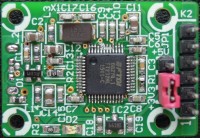Hi-Speed USB UART [150387-1]

In this project we are interested in a Hi-Speed USB UART. The PCB is designed to be mounted on a side panel to save space. No mounting holes on the bottom are necessary nor having to mount it on another PCB first (like so many BOBs). The PCB is only 22 x 33 mm and should fit in almost any enclosure. It’s fixed with four 2 mm screws (in most cases 10 mm length should be enough).
In this project we are interested in a Hi-Speed USB UART. The PCB is designed to be mounted on a side panel to save space. No mounting holes on the bottom are necessary nor having to mount it on another PCB first (like so many BOBs). The PCB is only 22 x 33 mm and should fit in almost any enclosure. It’s fixed with four 2 mm screws (in most cases 10 mm length should be enough). The USB connector ( K1) is mounted vertically on the bottom of the PCB, so it can fit through a fairly thick panel.
In the beginning of Februari 2015 we added a project called ‘130542 Multipurpose FT232H USB Module’. The key component is the FT232H from FTDI. It’s a multifunction IC (as the manufacturer calls it “Single Channel Hi-Speed USB to Multipurpose UART/FIFO IC"). Why use this IC here instead of the old FT232R, well at the moment we started this design it was cheaper and it still is. Of course you don’t really need Hi-Speed for a UART. By default (if no EEPROM is connected or programmed) the FT232H is a UART. So just plug it in and if the latest virtual Com Port drivers (VCP) are installed (look at http://www.ftdichip.com) you should see a ‘USB Serial Port (COMxx)’ under ‘Ports’ and a ‘USB Serial Converter’ under ‘Universal Serial Bus controllers’ (in Windows 7). The output connector K2 is according to the standard pinout of FTDI (GND/CTS/VCC/TXD/RXD/RTS). We’ve added a small 3.3 V regulator IC2 so 3.3 V or 5 V can be selected by jumper JP1 as the output voltage VCC. The I/O pins are +3.3 V cells, which are +5V tolerant. In most cases a high level of 3.3 V is also a valid high level for 5 V logic. The small 3.3 V regulator can deliver about 150 mA. The FT232H has an internal regulator but it’s best to use it only for the IC itself.




Discussion (1 comment)
JohnHind 9 years ago
The choice of a 'High Speed' device (as opposed to 'Full Speed' which in the bizarre world of USB is slower than 'High speed'!) seems questionable for a UART-only design given the tradeoffs in terms of external component count, high pin-count and '5v tolerant' rather than full 5v. IO capability. It is nice to be able to set the USB idents so that PC software does not have to play 'hunt the COM port' and this requires the EPROM you left out of this design, but which is built in to the Full Speed chips.
FTDI's Full Speed devices are rated to 3M Baud and it is hard to imagine many microcontroller UARTs capable of saturating this. Furthermore can the driver stacks in computers reach this rate? I'd be interested if you have any test results on this. Yes, the FT232R is now more expensive, but there is also the FT230X. The latter is not 5v capable either, but as you point out in the article, the CY7C65211 is, and is cost competitive. Not relevant for UART only, but the Cypress chip does have a major disadvantage over the FTDI chips for half-duplex such as RS458 - no driver enable output.
On another point, why not have your own excellent ECC pinout on the board, maybe as an option alongside the FTDI pinout? And it would be nice to have pads for indicator LEDs which the user can populate or not to taste.